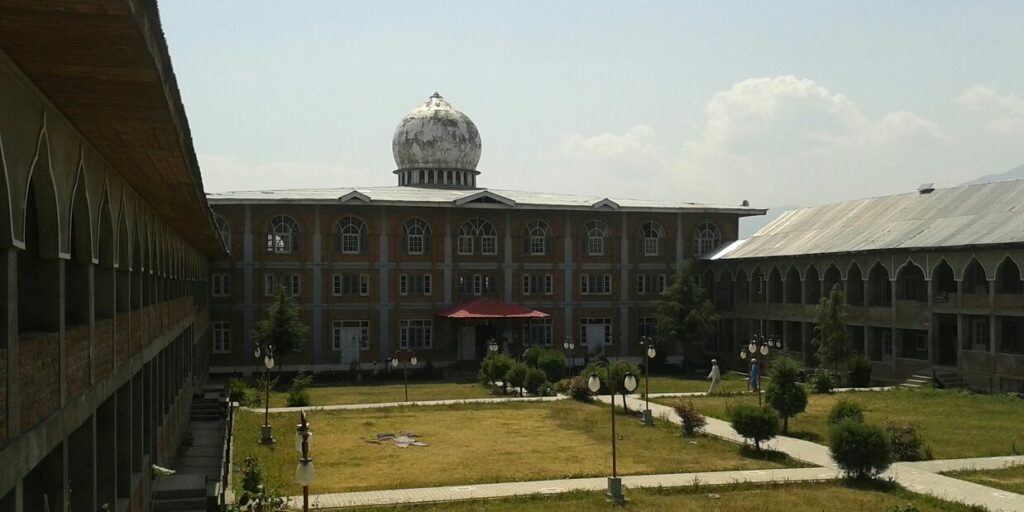

In Kashmir, madrassas have historically served as more than centres of religious learning. They are key institutions of cultural preservation, community cohesion, and pedagogic continuity. They shape religious discourse, sustain Arabic-Persian literary traditions, and integrate sacred and secular knowledge. In recent years, however, the state has intensified regulatory interventions under the banner of modernisation, citing concerns around curriculum relevance, employability, and national integration. While educational reform is a legitimate objective, the nature of these interventions raises questions about autonomy and securitisation, particularly in a conflict-ridden region like Kashmir.
State-led initiatives advocating curricular standardisation and administrative oversight often frame madrassa reform as part of a developmental agenda. But in Kashmir, these reforms cannot be divorced from the larger political aims of surveillance and control. Do reforms seek to improve educational outcomes, or do they reflect an attempt to domesticate religious institutions within an already securitised space? To explore these tensions, examining the historical evolution of madrassas and their shifting relationship with political authority is essential.
Rooted in Indo-Persian traditions, Kashmiri madrassas once operated with considerable autonomy, integrating religious sciences with disciplines like medicine, history, and philosophy. This autonomy was eroded under the Dogra regime (1846–1947), which marginalised religious education in favour of Western-style institutions, constructing a hierarchy that framed Islamic learning as regressive.
Following Jammu and Kashmir’s accession to India in 1947, state approaches fluctuated between inclusion and regulation. Sheikh Abdullah’s government promoted secular education while attempting to fold madrassas into a broader nationalist framework. Though presented as modernisation, these efforts revealed an unease with religious institutions functioning outside state oversight. The insurgency of 1989 marked a turning point, with madrassas increasingly cast as ideological threats. State narratives began linking them to militancy, reinforcing perceptions of madrassas as spaces of radicalisation.
This led to heightened surveillance and a reconfiguration of state-madrassa relations—from potential collaborators in educational reform to objects of suspicion and control. These policy approaches, while framed as reforms, often overlook the intellectual, cultural, and social roles that madrassas continue to play. By failing to engage these institutions on collaborative terms, state interventions risk delegitimising autonomous religious education, and thereby reducing complex epistemic traditions to security concerns.
Negotiation, resistance, and the politics of reform
Contrary to state narratives that portray madrassas as passive recipients of reform, these institutions actively negotiate their place within the broader political order. Their engagement with state-driven modernisation efforts is neither linear nor uniform; rather, it is shaped by a complex interplay of adaptation, resistance, and strategic compliance.
State-led attempts to reform madrassas include efforts to standardise curricula, impose financial oversight, and bring madrassas under the Jammu and Kashmir Board of School Education (JKBOSE). Justified through discourses of development and security, these reforms depict religious institutions as spaces requiring transformation. Yet, many madrassas resist such directives, declining government funding to maintain autonomy from state structures.
A key site of contestation has been financial schemes like the Scheme for Quality Education in Madrasas (SQEM) and Infrastructure Development in Minority Institutions (IDMI). The Indian education ministry has voiced concern over Kashmiri madrassas’ reluctance to access such funds, often attributing this to deep-seated suspicion of state intentions. While state authorities have encouraged registration and participation, many madrassa administrators fear that financial dependence may lead to greater surveillance and curricular control. Consequently, most madrassas continue operating outside JKBOSE’s regulatory framework, safeguarding their pedagogical and institutional independence.
Beyond financial incentives, the state has also employed symbolic and strategic outreach, such as setting up a Madrassa Board in Jammu and Kashmir and the military’s distribution of educational materials. These aimed to reinforce a securitised perception of madrassas as potential sites of ideological deviation. Such initiatives, framed as benign developmental measures, effectively function to deepen the state’s reach into religious education and socialisation.
In this context, it is essential to differentiate between reform and state control masquerading as reform. Across South Asia, there exists a robust discourse among Islamic scholars and civil society regarding the need for internal madrassa reform. These internal discussions often focus on updating curricula to include modern subjects, improving pedagogical methods, enhancing critical thinking, and addressing the socio-economic needs of students, without compromising the theological integrity of Islamic education. Importantly, such reformist impulses emerge from within the tradition itself and reflect a desire to make religious education more responsive to contemporary realities, rather than a capitulation to external pressure.
In India, organisations like the Jamiat Ulama-i-Hind have consistently defended madrassa autonomy while also forming committees to assess internal reform—especially in response to state scrutiny, such as Uttar Pradesh’s survey of unrecognised madrassas. While these committees signal a willingness to engage with evolving educational expectations, their impact has largely remained consultative—producing policy recommendations and public statements that affirm the legitimacy of madrassas, but rarely resulting in systematic change.
However, recent initiatives indicate a shift towards more structured internal reforms. For instance, in September 2022, the Jamiat Ulama-i-Hind convened a significant gathering of nearly 200 madrassa rectors to address the Uttar Pradesh government’s survey of unrecognised madrassas. During this meeting, a three-point plan was proposed, focusing on rectifying legal and institutional shortcomings within madrassas and facilitating the introduction of modern education through open schooling formats. In Kashmir, seminaries like Darul Uloom Raheemiyyah and Darul Uloom Bilaliya have independently established modern educational branches such as the Faiz-e-Aam Secondary School and schools under the Bilaliya Madrasa Trust. These integrate secular subjects while retaining an Islamic ethos. Such examples echo similar trajectories in Pakistan, where the Deobandi establishment created the Wifaq ul Madaris Al-Arabia in 1959 to unify curricula and examinations, entirely as an internal initiative.
These instances demonstrate that reform and tradition are not mutually exclusive; internal deliberation and transformation are part of madrassas’ historical evolution. The key issue, then, is not a rejection of reform per se, but the source and nature of the reform. Many madrassas express concern that engagement with state structures often undermines autonomy and introduces mechanisms of ideological control. Nevertheless, not all forms of state involvement are resisted. Seminary leaders often distinguish between coercive intervention and supportive engagement. For example, infrastructure support, fair wages for teachers, or sanitation improvements are usually welcomed—so long as they do not compromise autonomy or introduce surveillance.
Interviews with teachers and administrators, especially from Darul Uloom Bilaliya, reflect this pragmatic approach. They are open to partnerships that enhance institutional capacity, provided they retain control over religious curricula and administration. The objection is not to regulation in principle but to regulation that displaces religious authority and reorients madrassa education toward state-defined goals. In this sense, the question is not about regulation versus autonomy, but about negotiating the terms of engagement.
The curriculum is a central site of this negotiation. Secular subjects like science and social studies are increasingly incorporated into madrassa systems. However, these are not adopted wholesale but reframed through Islamic epistemologies, ensuring that religious instruction remains central. This hybridity reflects what Talal Asad calls the “intertwined genealogies” of the religious and the secular, in his authoritative work on the subject, Genealogies of Religion. Madrassas, by embedding secular knowledge within religious frameworks, assert epistemic agency and resist the homogenising pressures of state reforms.
These negotiations also impact students’ identities and aspirations. Madrassas serve not only as religious institutions but also as spaces where a sense of belonging is constructed—often in contrast to dominant secular-nationalist discourses. Exposure to secular knowledge equips students with the tools to navigate broader socio-political systems, cultivating civic awareness without necessarily severing religious commitments. This challenges binary portrayals of madrassa students as either radicalised dissenters or passive recipients of state ideology. Instead, they often straddle multiple, sometimes contradictory, forms of belonging.
Institutional responses to state intervention vary. Some adopt a strategy of partial adaptation—integrating secular content on their own terms without yielding control. Others remain resistant, refusing to register or align with state frameworks, instead operating parallel systems of education and credentialing. These are not merely acts of defiance, but calculated choices to preserve religious authority and institutional legitimacy. By choosing how and when to engage, madrassas exert agency in shaping their role within the polity.
Understanding madrassa-state relations in Kashmir requires a move beyond simplistic binaries of compliance and resistance. These institutions are neither isolated relics of tradition nor blank slates for modernisation. They are embedded in the broader structures of power, governance, and identity, and respond accordingly. The state’s drive to reform madrassas must be seen within a larger project of managing religious life in a politically contested region.
As this regulatory landscape continues to evolve, the push and pull between state authority and madrassa autonomy will persist. What emerges from this is a complex, contingent relationship defined not by submission or defiance alone, but by tactical negotiation and political consciousness. Recognising this complexity is key to understanding how madrassas function—not as static entities but as dynamic institutions navigating the pressures of reform, resistance, and survival.
The cultural stakes: Preserving Kashmiri identity
Madrassas in Kashmir function as more than religious schools; they are vital institutions for the preservation of Kashmiri Muslim identity. Historically, these institutions have served as repositories of Islamic teachings, cultural heritage, and spiritual traditions, particularly influenced by Sufi and Rishi philosophies that emphasise communal harmony and moral discipline. In a region marked by contested sovereignty and shifting state narratives, madrassas act as crucial spaces where Kashmiri Muslims reinforce their historical and religious identity against external pressures.
Madrassas have long played a role in safeguarding and transmitting Kashmiri Islamic traditions. Through Quranic teachings, Islamic jurisprudence, and ethical instruction, they provide not only religious literacy but also a cultural framework rooted in local history. The influence of figures like Bulbul Shah and Mir Sayyid Ali Hamdani established a distinct Kashmiri Islamic tradition that blends spiritual introspection with social cohesion. Even today, many madrassas retain these teachings, emphasising local Sufi practices alongside conventional Islamic education.
However, this role of cultural preservation has become increasingly fraught in the face of state-imposed educational reforms and security concerns. The broader cultural stakes of these regulations are profound. The state promotes an official narrative of “Kashmiriyat”—a syncretic regional identity that ostensibly transcends religious divisions. However, this framework often marginalises the distinctiveness of Kashmiri Muslim traditions, reducing them to a sanitised cultural aesthetic rather than an active, lived religious identity. By attempting to subsume madrassas into a state-defined educational system, these policies risk eroding a vital element of Kashmiri Muslim life, replacing an organic tradition of religious scholarship with an externally imposed structure.
The political implications of regulating religious education in a disputed region are significant. Attempts to standardise curricula may lead to unintended consequences, such as increasing sectarian divides within the madrassa system, where different institutions align with ideological factions in response to state intervention. Moreover, as madrassas navigate between adaptation and defiance, they become sites of subtle resistance against state control. This resistance is not always overt; it often manifests in the ways madrassas selectively incorporate modern subjects while framing them within Islamic epistemologies.
For Kashmiri youth, the transformation of madrassas impacts their religious and civic identities. As the state attempts to regulate religious education, young students are increasingly caught between two competing narratives: one that seeks to assimilate them into a secular-national framework and another that emphasises religious continuity and cultural preservation. This tension can foster a generation that is simultaneously aware of their rights as citizens and resistant to narratives that seek to dilute their religious identity. In a contested region like Kashmir, where identity is inherently political, the madrassa becomes an enduring institution in the struggle for cultural self-determination.
The future of madrassas in Kashmir is deeply entangled with questions of state power, religious authority, and cultural resilience. As state oversight expands, these institutions must navigate an increasingly complex landscape—they seek to adopt modern educational standards while striving to preserve their religious core. The pressures exerted by regulatory frameworks and security concerns challenge their ability to operate as independent centres of learning and cultural preservation.
This raises a fundamental question about the limits of secular governance in a deeply contested space. Can the state accommodate religious education without imposing its ideological framework? Or does the integration of madrassas into state-regulated structures inevitably lead to the erosion of Kashmiri Muslim religious traditions? The answers to these questions will shape not only the future of religious education in Kashmir but also the broader socio-political landscape of the region.
Ultimately, madrassas remain central to Kashmir’s political struggle—not merely as institutions of religious learning but as sites where culture, education, and resistance intersect. Whether through adaptation, defiance, or negotiation, they continue to play a critical role in shaping the identity of Kashmiri Muslims in the face of external pressures. The battle over madrassas is, at its core, a battle over the right to define and sustain a distinct cultural and religious identity in one of the most politically charged regions in the world.
The author of this piece requested not to be identified out of security concerns.
Related Posts






